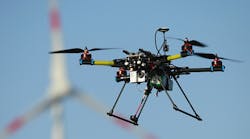WASHINGTON, D.C. — It was a fine summer day over the airport at Charlotte, N.C., and a CRJ200 commuter jet was preparing to land when its pilots spotted something odd outside their cockpit window — a drone.
The unmanned craft flew about five to 10 feet above the plane, the captain later wrote to NASA’s Aviation Safety Reporting System. He said the event lasted one to two seconds, and the silver or blue drone appeared to be of the hobby or home-built type.
“We notified ATC (air traffic control) and they did a good job of making callouts to other traffic in the area,” the captain wrote. “See and avoid. Don’t hit them. Don’t allow them in busy ... airspace.”
As more and more small radio-controlled drones appear in American skies, so do worries that someday, one might bump into a full-sized airplane — possibly with grim results.
Nearly 700 close encounters with drones have been reported by pilots so far this year, according to Federal Aviation Administration statistics. That’s about triple the number for all of last year, according to The Washington Post, which first reported the FAA figures Friday.
“Because pilot reports of unmanned aircraft have increased dramatically over the past year, the FAA wants to send a clear message that operating drones around airplanes and helicopters is dangerous and illegal,” the aviation authority said in a statement. “Unauthorized operators may be subject to stiff fines and criminal charges, including possible jail time.”
An increasing aerial risk
Since the start of August, there have been at least 75 close calls, including a dozen during a single Sunday earlier this month, in every corner of the nation. In California, at least 13 incidents have been reported in which drones are said to have disrupted efforts to put out wildfires.
Chesley “Sully” Sullenberger — who famously splash-landed a US Airways Airbus A320 onto the Hudson River in New York with no loss of life after a mid-air run-in with migrating birds — is among those who sense danger for the flying public.
“Because they are easy to get and they’re relatively inexpensive, these devices are becoming ubiquitous,” Sullenberger told CBS’s “Face the Nation” earlier this month. “It allows people to do stupid, reckless, dangerous things with abandon ... (but) it has been difficult to catch them in the act. This must stop.”
In a report this past week, Lloyd’s of London cited “negligent or reckless pilots” and “patchy” regulation as key considerations for insurers as drones become increasingly commonplace worldwide.
The Consumer Electronics Association expects global sales of consumer-oriented drones to approach 425,000 units this year, up 65% from 2014.
The FAA is still drafting a comprehensive set of regulations for drones in U.S. skies, in anticipation of their widespread use for tasks as varied as agricultural surveying to parcel delivery.
But for recreational drone pilots, the rules now are clear: no higher than 400 feet, always within sight and nowhere near an airport without prior permission.
“As more people buy remote controlled drones, we need to make sure they act responsibly – especially near airports and flight paths,” Senator Richard Blumenthal, a member of the Senate transportation committee that oversees the FAA, said Friday on his Twitter feed.
Legislation in the works
Blumenthal is co-sponsor of a proposed Consumer Drone Safety Act that would establish a more thorough set of rules on when, where and how recreational drones are flown.
Rich Hanson, government and regulatory affairs director for the Academy of Model Aeronautics, told AFP on Friday there is no doubt that some drone operators are acting irresponsibly.
“But the vast majority that are being seen flying inappropriately are doing so just because they don’t know any better,” said Hanson, whose organization is part of a “Know Before You Fly” educational campaign to spread the gospel of safe drone flying.
Hanson, a drone enthusiast who also holds a commercial pilot’s license, cited another factor: the dubious reliability of GPS devices that are appearing on a growing number of small drones.
While the technology is bound to improve over time, it’s not uncommon for a drone to lose a GPS signal and zoom off on its own, its operator helpless to control it.
As for a mid-air collision, Hanson said the prospect of a small drone — defined as being 55 pounds or smaller — knocking out a commercial airliner is “highly unlikely.”
“The idea that we have a catastrophic failure on the horizon that’s going to kill hundreds of people, I think, is certainly overstated,” he said.
That said, if just one drone collides with an aircraft, “it’s one too many,” Hanson added.
by Robert MacPherson
Copyright Agence France-Presse, 2015



